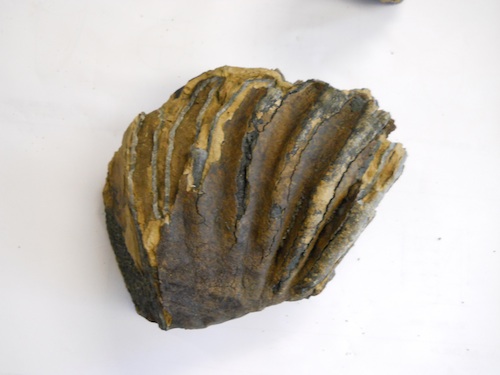We're open daily! View holiday hours
Science News
Tooth on Display
December 21, 2012
by Ted Olsson

In September 2012, a mammoth tooth was discovered more than 100 feet below sea level in downtown San Francisco during construction on the new Transbay Terminal Center. At the time, the organization behind the construction pledged the fossil to the Academy. And it has arrived at our Naturalist Center—now on view with similar fossils.
At the time, a paleontologist associated with the dig made a passing comment about it possibly being a Colombian mammoth (Mammuthus columbi), although he also admitted that he hadn’t taken a good look at it yet. Academy scientists have now confirmed that this tooth indeed belonged to a Columbian Mammoth.
Both Columbian and Wooly mammoths roamed North and Central America 8,000-150,000 years ago. These giants had massive tusks and six sets of four molars in their jaws—new ones replacing old ones.
At the end of the last great ice age, California’s coast extended to the Continental Shelf, beyond the Farallon Mountains, whose tips are now islands, 28 miles west of today’s coastline. Ocean breezes cooled lush valleys and open plains where ancient wildlife was abundant. Since then, the ocean has risen about 300 feet.
What can you learn by exploring a long-buried tooth? By distinguishing between mammoth and mastodon teeth, scientists understand that they coexisted: because they had different diets, they therefore didn’t compete for food. The Naturalist Center’s exhibit includes giant bison, saber-toothed cat, and dire wolf fossils.
We can all learn from natural objects by asking pertinent questions. These animals once lived here. What has changed? How? Why? What questions can you ask looking at our exhibit? The Naturalist Center staff can find age-appropriate answers to set anyone on a lifelong journey of inquiry. The same inquiry that likely sparked each of the scientists here at the California Academy of Sciences.
Ted Olsson is a docent at the Academy and on the advisory committee for the Transbay Terminal.